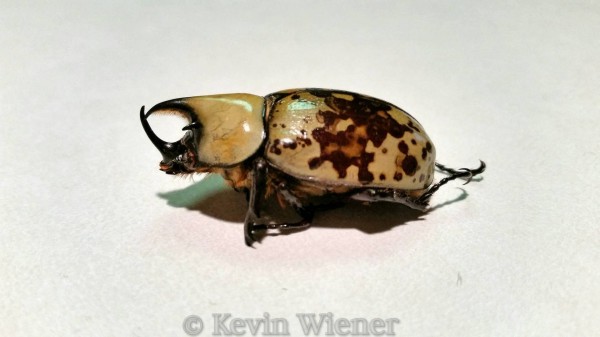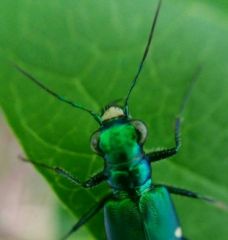Beetles
Order: Coleoptera
Order Coleoptera: The Beetles (not the band)
Pronounced: “coe-lee-OP-tera,” or less frequently “collie-OP-tera”
Linguistic Aside: from the Greek Koleon “sheath” and Pteron “wing,” because the membranous wings used by the beetle to fly, are typically “sheathed” between the beetle's back and the hardened forewings called “elytra.”
(one elytron, two elytra)
View Beetle Category Here
General Beetle Information
Meanwhile, (linguistic aside continues) the term “beetle” comes from the Old English “b?tan” meaning “bite” and the suffix “-el” meaning “apt to.” And while many beetles are apt to bite if handled roughly, not all are, and not all are even capable of biting people. However, be careful, that's “apt to bite” would seem like good advice to anyone tempted to pick up an unknown creepy crawly.
And, beetles are probably the most common creepy crawlies anyone might be tempted to pick up, seeing as how there are some 400,000 named species worldwide and probably another 400,000 to 600,000 species yet to be discovered, described and named.
So, what do most beetles have in common?
The feature that immediately distinguishes a beetle from most other insects for most people is the hardened shell-like covering of the beetle's back, the elytra. But there always seem to be exceptions, and one finds the odd beetle with no wings or elytra.
Literally! Thylodrias contractus lacks wings and elytra, and it's commonly called the "Odd Beetle." It looks like louse or some kind of larva. The odd beetle larva looks like a little woolly bear, the adult is just... less fuzzy.
Speaking of larvae...
(one larva, two larvae)
Linguistic aside: the “ae” in Classical Latin is supposed to be pronounced like “eye,” and Ecclesiastical Latin changes that to “eh” or perhaps like “ay” in “say,” but we Americans (I can't speak for all English speakers) always seem to butcher our Latin, so the “ae” sounds like “ee” is “feet.”
So, one larva, two larvae. (I still sometimes find myself saying “larv-eye” following the Classical Latin, but it sounds odd to other American Latin butcher, so I tend to relax my prescriptionist tendencies and butcher away so as not to stand out in crowds.)
All beetles undergo complete metamorphosis, that is, they start out as eggs, they hatch into larvae, the larvae grow larger through various stages, called “instars,” they pupate as... pupae, and emerge from pupae as full sized, fully formed, sexually mature adults, called “imagos.”
(one pupa, two pupae)
Linguistic aside: Fortunately for this word, we palatalize the word “pupate” in English, in other words, we say “pyoo-pate,” and we tend to butcher the Latin in kind with “pyoo-pa” and “pyoo-pee,” while the Classical Latin would have us saying “poo-pa” and “poo-pie,” and normal English butchery without the palatalization would have us talking about bugs emerging from poopy.
Which brings us to the complete metamorphosis of the dung beetle. Dung Beetles lay their eggs in poopy, the eggs hatch into larvae that eat the poopy, they pupate in the poopy and emerge from their poopy as adults.
So, all beetles undergo this sort of complete metamorphosis. No exceptions... except... some females emerge from their pupae as full sized, fully formed, sexually mature adults,... that look like larvae,... which look more like worms than beetles.
So, what's a beetle supposed to look like?
Viewed from above, which is the way you typically first see them, they are usually oval shaped, ranging from a very rounded oval, like you see in ladybugs, to a very elongated oval, like what you see in click beetles. And while the ovalness of ladybugs and click beetles is smooth connecting abdomen to thorax and thorax to head, many beetles have a distinct interruption in the oval pattern between their abdomens and their thoraces.
(one thorax, two thoraces, pronounced “thor-a-sees,” although thoraxes is also acceptable)
Many beetles have this sort of distinct separation between their thoraces and heads as well. And, there are any number of sometimes strange variations on the theme, like the long-necked beetle that has a skinny lengthened thorax that looks like a neck.
And then there are the “add-ons,” the long snouts of the weevils, the horns and pincers of the rhinoceros beetles and stag beetles, the feather-like legs of the whirligig beetles. And the rove beetles look more like earwigs than anything else.
There are well over 100 distinct beetle families represented in North America. The following list of about 30 families includes most of the species that are considered pests as well as the more popular (because they're pretty or otherwise fascinating) species.

List Of Other Beetles:
Anobiidae – Woodworms – several pests species
including Spider Beetles
Bostrichidae – Auger Beetles – several pests species
including Powderpost Beetles
Buprestidae – Jewel Beetles
Cantharidae – Soldier Beetles
Carabidae – Ground Beetles – very large and diverse family (apt to bite)
including Bombardier Beetles (beware explosive farts)
also including Tiger Beetles
Cerambycidae – Longhorn Beetles – very large and diverse
Cleridae – Checkered Beetles
Chrysomelidae – Leaf Beetles – very large and diverse family
including Chafers
also including Tortoise Beetles
Coccinellidae – Ladybugs – very large and diverse family
Curculionidae – Weevils – several pests species – very large and diverse family
Dermestidae – Skin Beetles – several pests species
including Carpet Beetles and other pests
Dytiscidae – Predaceous Diving Beetle
Elateridae – Click Beetles (flip them onto their backs)
Endomychidae – Handsome Fungus Beetles
Erotylidae – Pleasing Fungus Beetles (pleasing smell)
Gyrinidae – Whirligig Beetles
Histeridae – Clown Beetles
Lampyridae – Fireflies
Lanthriidae – Plaster Beetles
Lucanidae – Stag Beetles (apt to bite)
Lycidae – Netwinged Beetles
Meloidae – Blister Beetles (do not handle)
Nitidulidae – Sap Beetles
Passalidae – Bess Beetles (apt to bite)
Phengodidae – Glowworms
Scarabidae – Scarabs – very large and diverse family (worshiped by Ancient Egyptians)
including Dung Beetles (wash hands after handling)
Silphidae – Carrion Beetles (wash hands after handling)
Silvanidae – Silvanid Flat Bark Beetles
Staphylinidae – Rove Beetles – very large family, not as diverse as you would think
Tenebrionidae – Darkling Beetles – several pests species
including Flour Beetles
also including Stink Beetles (stop smelling fingers after handling)
Zopheridae – Ironlad Beetles (some make jewelry out of them)
PEST BEETLES
(lines without the ? refer to lines with the ?)
Alphabetical List of Common Household and Agricultural Pests
American Wheat Weevil (alt name: Lesser Grain Borer)
Asian Ladybug (see Ladybugs)
Asian Longhorn Beetle (see Longhorn Beetles)
Auger Beetles (Family: Bostrichidae)
Lesser Grain Borer (Rhyzopertha dominica (Fabricius)) – stored cereal grains
Powderpost Beetles (subfamily: Lyctinae) – wood
Brown Lyctus Beetle (Lyctus brunneus (Stephens))
European Lyctus Beetle (Lyctus linaris (Goeze))
Powderpost Beetle (Lyctoxylon japonum Reitter)
Powderpost Beetle (Minthea rugicollis (Walker))
Southern Lyctus Beetle (Lyctus planicollis LeConte)
Velvety Powderpost Beetle (Trogoxylon parallelopipedum (Melsheimer))
Western Lyctus Beetle (Lyctus cavicollis LeConte)
Australian Wheat Weevil (alt name: Lesser Grain Borer)
Billbug (see weevil)
Blister Beetles (Family: Meloidae) – 400 species in North America
Ashgray Blister Beetle (Epicauta fabricii (LeConte, 1853))
Black Blister Beetle (Epicauta pennsylvanica (De Geer, 1775))
Margined Blister Beetle (Epicauta funebris Horn, 1873)
Oil Beetles (Genus: Meloe)
Striped Blister Beetle (Epicauta vittata (Fabricius, 1775))
Colorado Potato Beetle (see Leaf Beetles)
Cowpea Beetle (see Leaf Beetles)
Carpet Beetles (see Skin Beetles)
Cigarette Beetle (see Woodworms)
Click Beetles (Family: Elateridae) – almost 1,000 species in North America
Wireworms (Click Beetle larva)
Darkling Beetles (Family: Tenebrionidae)
Mealworm (Tenebrio molitor Linnaeus 1758) larva
Flour Beetle
Black Flour Beetle (Tribolium audax (Halstead))
Broadhorned Flour Beetle (Gnatocerus cornutus (Fabricius) 1798)
Confused Flour Beetle (Tribolium confusum Jacquelin du Val)
Depressed Flour Beetle (Palorus subdepressus (Wollaston) 1864)
Destructive Flour Beetle (Tribolium destructor Uyttenboogart, 1934)
False Black Flour Beetle (alt name: destructive flour beetle)
Longheaded Flour Beetle (alt name: confused Flour Beetle)
Red Flour Beetle (Tribolium castaneum (Herbst))
Slender Horned Flour Beetle (Gnatocerus maxillosus (Fabricius) 1801)
Smalleyed Flour Beetle (Palorus ratzeburgii (Wissmann))
Stink Beetles (Genus: Eleodes)
Death Watch Beetle (see Woodworms)
Dried Fruit Beetle (see Sap Beetles)
Drugstore Beetle (see Woodworms)
Elm Leaf Beetle (see Leaf Beetles)
Emerald Ash Borer (see Jewel Beetles)
False Powderpost Beetles (alt. name: Auger Beetles)
Flour Beetle (see Darkling Beetles)
Foreign Grain Beetle (see Silvanid Flat Bark Beetles)
Fur Beetle (see Skin Beetles)
Furniture Beetle (see Woodworms)
Grain Borer (alt name: Lesser Grain Borer)
Granary Weevil (see Weevils)
Ground Beetles (Family: Carabidae)
Harlequin Ladybird (alt name: Asian Ladybug)
Halloween Lady Beetle (alt name: Asian Ladybug)
Japanese Beetle (see Scarab Beetles)
Jewel Beetles (Family: Buprestidae)
Emerald Ash Borer (EAB) (Agrilus planipennis Fairmaire, 1888)
Ladybug beetles (Family: Coccinellidae)
Asian Ladybug (Harmonia axyridis (Pallas, 1773))
Larder Beetle (see Skin Beetles)
Leaf Beetles (Family: Chrysomelidae)
Elm Leaf Beetle (Xanthogaleruca luteola (Müller, 1766))
Colorado Potato Beetle (Leptinotarsa decemlineata Say, 1824)
Cowpea Beetle (Callosobruchus maculatus (Fabricius, 1775))
Lesser Grain Borer (see Auger Beetles)
Longhorn Beetles (Family: Cerambycidae)
Asian Longhorn Beetle (Anoplophora glabripennis (Motschulsky, 1853))
Mealworm (see Darkling Beetles)
Mountain Pine Beetle (see Weevils)
Pantry Beetles
Rice Weevil (see Weevils)
Granary Weevil (see Weevils)
Lesser Grain Borer (see Auger Beetles)
Cigarette beetles (see Woodworms)
Drugstore beetles (see Woodworms)
Warehouse beetles (see Skin Beetles)
Cabinet beetles (see Skin Beetles)
Mealworms (see Darkling Beetles)
Spider beetles (see Woodworms)
Foreign Grain Beetles (see Silvanid Flat Bark Beetles)
Confused Flour Beetle (see Darkling: Flour)
Red Flour Beetle (see Darkling Beetles)
Sawtoothed Grain Beetle (see Silvanid Flat Bark Beetles)
Pine Bark Beetles (alt name: Mountain Pine Beetle or Southern Pine Bark Beetle)
Plaster Beetles (Family: Lathridiidae)
Powderpost Beetles (see Auger Beetles or Woodworms)
Sap Beetles (Family: Nitidulidae)
Dried Fruit Beetle (Carpophilus hemipterus (Linnaeus))
Sawtoothed Merchant Beetle (see Silvanid Flat Bark Beetles)
Scarabs (Family: Scarabidae and others)
Coconut Rhinoceros Beetle (Oryctes rhinoceros (Linnaeus, 1758))
Japanese Beetle (Popillia japonica Newman, 1841)
Skin Beetles (Family: Dermestidae)
Cabinet Beetle (Trogoderma inclusum LeConte)
Carpet Beetles
Black Carpet Beetle (Attagenus unicolor (Brahm, 1791))
Common Carpet Beetle (Anthrenus (Anthrenus) scrophulariae (Linnaeus, 1758))
Varied Carpet Beetle (Anthrenus verbasci (Linnaeus, 1767))
Woollybear (carpet Beetle larva)
Fur Beetle (Attagenus pellio (Linnaeus, 1758))
Khapra Beetle (Trogoderma granarium Everts, 1898)
Larder Beetle (Dermestes lardarius Linnaeus, 1758)
Warehouse Beetle (Trogoderma variabile Ballion)
Silvanid Flat Bark Beetles (Family: Silvanidae)
Foreign Grain Beetle (Ahasverus advena (Waltl, 1832))
Sawtoothed Merchant Beetle (Oryzaephilus surinamensis (Linnaeus, 1758))
Southern Pine Beetle (see Weevils)
Spider Beetles (see Woodworms)
Stink Beetles (see Darkling Beetles)
Stored Grain Borer (alt name: Lesser Grain Borer)
Weevils
Billbug (Sphenophorus Schoenherr, C.J. 1838)
Boll Weevil (Anthonomus grandis Boheman, 1843)
Granary Weevil (Sitophilus granarius (Linnaeus, 1758))
Mountain Pine Beetle (Dendroctonus ponderosae Hopkins, 1902)
Rice Weevil (Sitophilus oryzae (Linnaeus, 1763))
Southern Pine Beetle (Dendroctonus frontalis Zimmermann, 1868)
Wheat Weevil (alt name: Lesser Grain Borer or Granary Weevil)
Wireworms (see Click Beetles)
Wheat Weevil (alt name: Lesser Grain Borer or Granary Weevil)
Woodworm Beetles (Family: Anobiidae)
Cigarette Beetle (Lasioderma serricorne (Fabricius, 1792))
Death Watch Beetle (Xestobium rufovillosum (De Geer, 1774))
Furniture Beetle (Anobium punctatum De Geer, 1774)
Powderpost Beetles (see Auger Beetles or Woodworms)
Spider Beetles
American Spider Beetle (Mezium americanum Laporte de Castelnau, 1840)
Australian Spider Beetle (Ptinus tectus Boieldieu, 1856)
Golden Spider Beetle (Niptus hololeucus (Faldermann ) , 1836)
Shiny Spider Beetle (Mezium affine Boieldieu, 1856)
Whitemarked Spider Beetle (Ptinus fur (Linnaeus, 1758))
Disclaimer: I'm not a professional entomologist, just an amateur, so I'm not compelled to be perfectly accurate and precise with my information about beetles. My professional training is actually in linguistics, so you may notice an occasional linguistic aside/diatribe. Contrary to popular opinion, not all linguists are the stodgy presciptionist types. Some, myself included, are more descriptionist, and tend to use words more artistically and inventively, so don't be surprised if you come across a word and find yourself saying, “that's not really a word, is it?”


